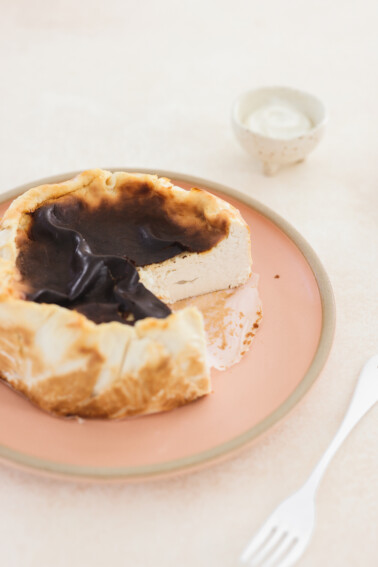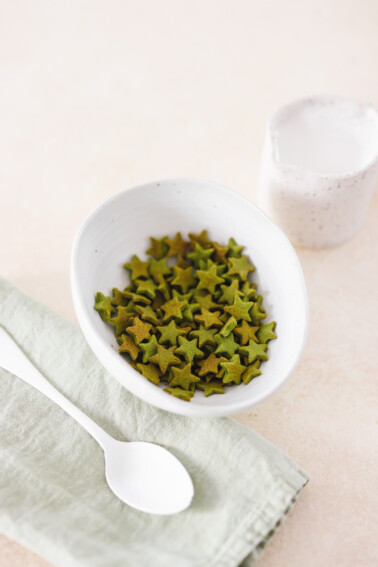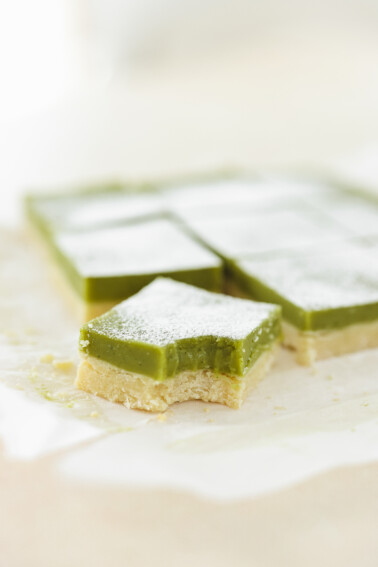This page may contain affiliate links, which means I will make a small commission for products purchased through my link.
This vegan pavlova recipe is a delicious dairy-free, plant-based version of a classic dessert. A crispy outside and soft marshmallowy middle, then topped with fresh fruit and vegan whipped cream. Easy, delicious, and totally vegan!
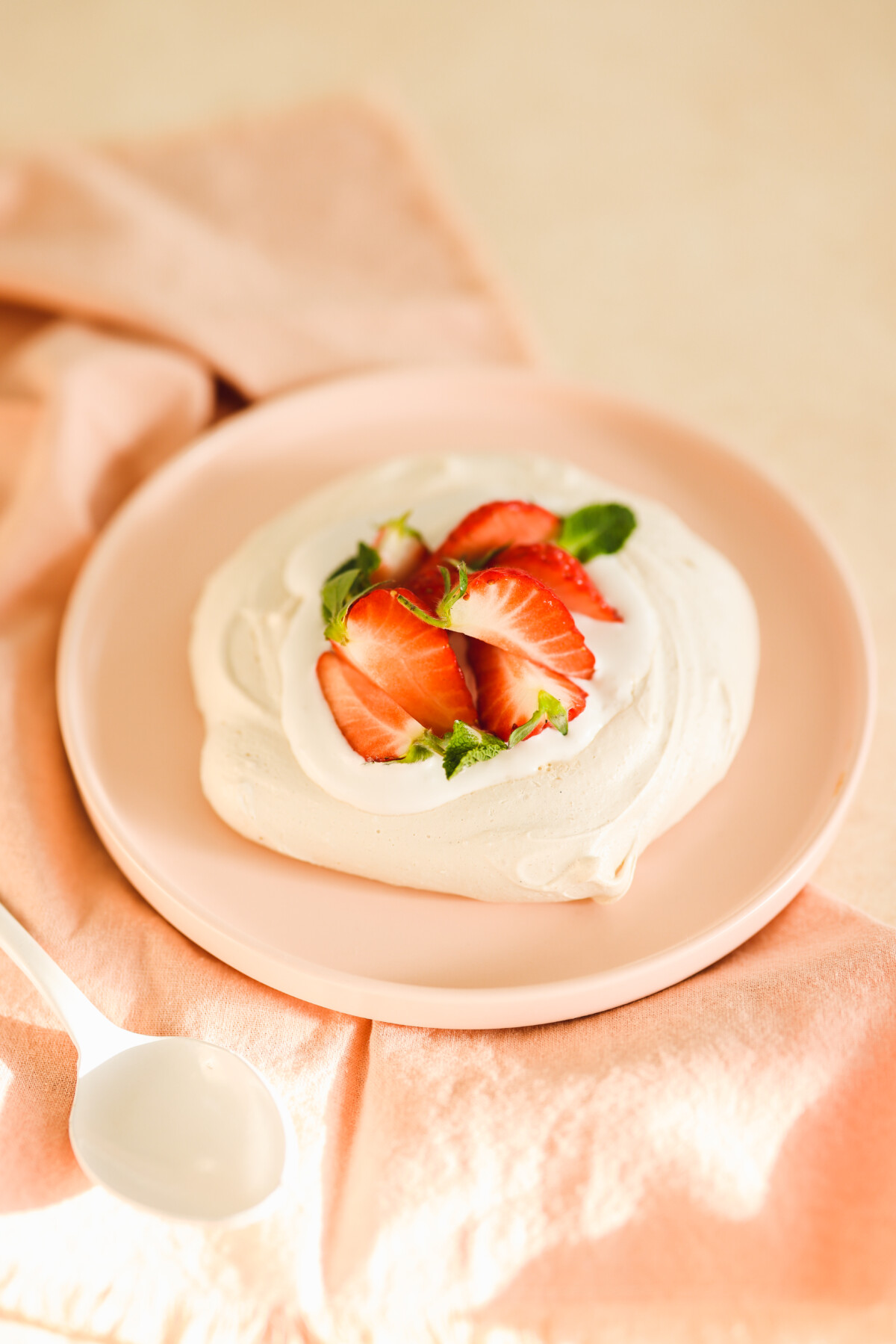
What is a Pavlova?
A pavlova is a popular dessert that is named after the Russian ballet dancer Anna Pavlova. It is a meringue-based dessert that is typically crisp on the outside and soft on the inside.
A pavlova is typically made by whisking egg whites until stiff peaks form and then gradually adding sugar to create a stable meringue mixture. The meringue is then shaped into a round or oval shape and baked at a low temperature until it becomes crisp and lightly golden on the outside. The center of the pavlova remains soft and slightly chewy.
It’s traditionally served with a topping of whipped cream and fresh fruits, such as strawberries, kiwi, passion fruit, or raspberries. The dessert has a delicious contrast of textures and flavors and is popular worldwide.
What Makes This Recipe Great
Because I want everyone to be able to share in this amazing dessert, I set out to make a vegan version that is just as delicious but has no eggs or dairy and is completely plant-based. My vegan pavlova relies on aquafaba to create a meringue-like texture instead of egg whites.
To make a vegan pavlova, the aquafaba is whisked with sugar and cream of tartar until stiff peaks form. It is then baked, resulting in a crispy outer shell and a soft, marshmallow-like interior (just like the traditional version!).
Garnish with various plant-based alternatives, such as coconut cream or non-dairy whipped cream, and fresh fruits, such as berries or tropical fruits.
Vegan Pavlova provides a plant-based, dairy-free option with the same delightful flavors and textures as the classic dessert.
Ingredient Notes
- aquafaba: Aquafaba is the brine from a can of chickpeas (garbanzo beans) that serves as the stabilizer for this recipe. Chickpea brine is an excellent substitute for eggs!
- cream of tartar
- xanthan gum
- organic cane sugar
- vanilla bean paste
- fresh strawberries
- vegan whipped cream: You can use your favorite whipped coconut cream or alternative vegan whipped topping.
Step-by-Step Instructions
Reduce the Aquafaba
- Add the aquafaba to a small pot over low heat and cook, stirring occasionally, until the volume reduces to half. You’ll want to end up with 1/4 cup of reduced aquafaba.
- Chill the reduced aquafaba by placing it in an ice bath. It should be cool to the touch before you start working with it.
Prepare the Pavlova
- Add the reduced aquafaba, cream of tartar, and xanthan gum to a stand mixer. Whip on high speed for about 5-8 minutes, pausing and scraping down any edges as needed. The mixture will firm up quite a lot, thanks to the xanthan gum.
- Slowly start to add the sugar, 2 tablespoons at a time, waiting 30 seconds in between each addition. Again, take breaks to scrape down the sides of the mixing bowl as needed. Once all the sugar has been incorporated, continue to whip for another 5 minutes and add the vanilla bean paste.
- When the mixture is ready, it should be almost marshmallow-like in texture, and you can test it by flipping the bowl over (it shouldn’t fall out of the bowl at all).
Bake the Pavlova
- Preheat the oven to 250F.
- Divide your mixture into three parts and transfer to a baking sheet lined with parchment paper, leaving 2-3 inches around all edges of the pavlovas. Use a spatula to make circular discs and then make a little well in the center for toppings later on.
- Bake the pavlovas for 2 hours and 15 minutes, making sure not to open the oven (even if you’re tempted to check on them, don’t!!!). After the 2 hours and 15 minutes pass, keep the door closed and turn the heat off completely. Let the pavlovas cool in the closed oven for another 1 hour and 30 minutes.
Garnish the Pavlova
- Once the pavlovas are cooked and cooled, top with a spoon of vegan whipped cream of choice to taste and any fruit like sliced strawberries, blueberries, mangoes, etc. Only top just as you’re about to serve, otherwise, the pavlovas will absorb the moisture and lose their crisp exterior.
Expert Tips
- I recommend using a stand mixer for this vegan pavlova recipe, but if you don’t have one, feel free to use a hand mixer.
- I shape the mixture into disks with a spatula, but you can transfer it to a piping bag and pipe them into shape if that is easier for you.
- To make your own vegan whipped cream, I recommend using a can of chilled full-fat coconut milk, a teaspoon of vanilla extract, and powdered sugar. The thick cream should have risen to the top of the can. Gently scoop out the solidified coconut cream into a mixing bowl, then using a hand mixer, blend at medium speed until peaks are formed. Sweeten to taste and store in the fridge to chill before serving.
Serving Tips
- Once the pavlovas are cooked and cooled, top with a spoon of vegan whipped cream of choice to taste and fresh fruit like sliced strawberries, blueberries, mangoes, etc.
- Only top just as you’re about to serve. Otherwise, the pavlovas will absorb moisture and lose their crisp exterior.
Storage Tips
- To store leftover vegan pavlova, let it cool completely, place it in an airtight container, and store it at room temperature in a cool, dry place. Do not store in the fridge and use within 1-2 days. Add toppings before serving.
Recipe FAQs
A vegan pavlova is made with aquafaba, the liquid from chickpeas, as a substitute for egg whites. It is whipped with sugar and baked to create a crispy exterior and soft interior. It is typically served with plant-based toppings like coconut cream and fresh fruits.
Meringue is a baked mixture of egg whites and sugar, while pavlova is a meringue-based dessert with a crisp shell and soft interior, typically served in a cake-like form topped with cream and fruits.
More Delicious Vegan Desserts
If you make this recipe, be sure to let me know what you think with a star rating and comment below. Follow me on Instagram for more delicious recipes!
Easy Vegan Pavlova Recipe (No Eggs!)
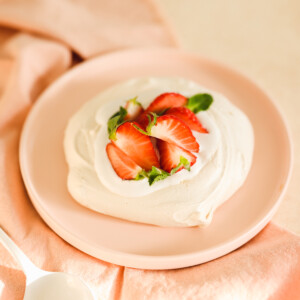
Equipment
- stand mixer or handheld whisk
- Nonstick Baking Mat or parchment paper
Ingredients
Vegan Pavlova Ingredients
- 1/2 cup aquafaba liquid brine from can of chickpeas
- 1/4 tsp cream of tartar
- 1/4 tsp xanthan gum
- 2/3 cup organic cane sugar granulated
- 1 tsp vanilla bean paste or use extract
To Serve
- 1 handful fresh strawberries sliced
- vegan whipped cream to taste
Instructions
Reduce the Aquafaba
- Add the aquafaba to a small pot over low heat and cook, stirring occasionally, until the volume reduces to half. You'll want to end up with 1/4 cup of reduced aquafaba.
- Chill the reduced aquafaba by placing in an ice bath. It should be cool to the touch before you start working with it.
Prepare the Pavlova
- Add the reduced aquafaba, cream of tartar and xanthan gum to a stand mixer. Whip on high speed for about 5-8 minutes, making sure to pause and scrape down any edges as needed. The mixture will firm up quite a lot thanks to the xanthan gum.
- Slowly start to add the sugar, 2 tablespoons at a time, waiting 30 seconds in between each addition. Again, take breaks to scrape down the sides of the mixing bowl as needed. Once all the sugar has been incorporated, continue to whip for another 5 minutes then add in the vanilla bean paste.
- When the mixture is ready, it should be almost marshmallow-like in texture and you can test it by flipping the bowl over (it shouldn't fall out of the bowl at all).
Bake the Pavlova
- Preheat the oven to 250F.
- Divide your mixture into three parts and transfer to a lined baking sheet, leaving 2-3 inches around all edges of the pavlovas. Use a spatula to make circular discs and then make a little well in the center for toppings later on.
- Bake the pavlovas for 2 hours and 15 minutes, making sure not to open the oven (even if you're tempted to check on them, don't!!!). After the 2 hours and 15 minutes passes, keep the door closed and turn the heat off completely. Let the pavlovas cool in the closed oven for another 1 hour and 30 minutes.
Garnish the Pavlova
- Once the pavlovas are cooked and cooled, top with vegan whipped cream of choice, to taste, and any fruit like sliced strawberries, mangoes etc. Only top just as you're about to serve, otherwise the pavlovas will absorb the moisture and lose their crisp exterior.
Notes
Expert Tips
- I recommend using a stand mixer for this vegan pavlova recipe, but if you don’t have one, feel free to use a hand mixer.
- I shape the mixture into disks with a spatula, but you can transfer it to a piping bag and pipe them into shape if that is easier for you.
- To make your own vegan whipped cream, I recommend using a can of chilled full-fat coconut milk, a teaspoon of vanilla extract, and powdered sugar. The thick cream should have risen to the top of the can. Gently scoop out the solidified coconut cream into a mixing bowl, then using a hand mixer, blend at medium speed until peaks are formed. Sweeten to taste and store in the fridge to chill before serving.
Serving Tips
- Once the pavlovas are cooked and cooled, top with a spoon of vegan whipped cream of choice to taste and fresh fruit like sliced strawberries, blueberries, mangoes, etc.
- Only top just as you’re about to serve. Otherwise, the pavlovas will absorb moisture and lose their crisp exterior.
Storage Tips
- To store leftover vegan pavlova, let it cool completely, place it in an airtight container, and store it at room temperature in a cool, dry place. Do not store in the fridge and use within 1-2 days. Add toppings before serving.
Nutrition information is automatically calculated, so should only be used as an approximation.

